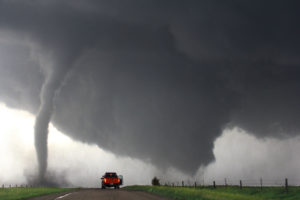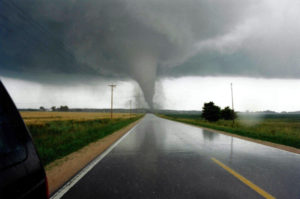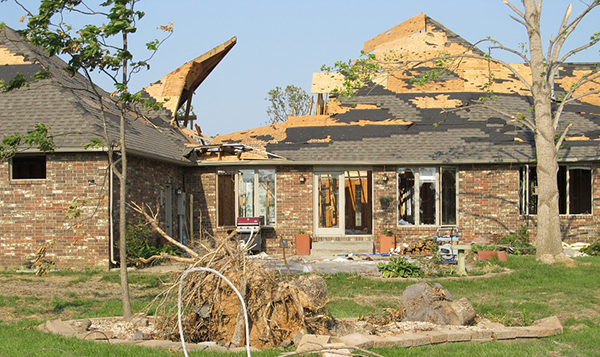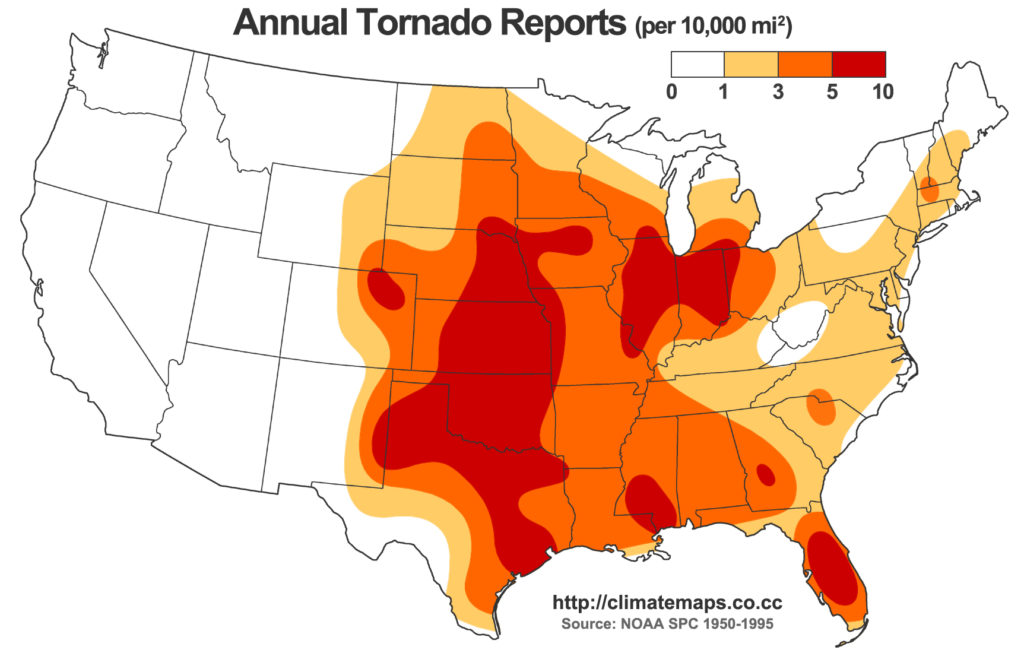A tornado is simply air spinning while in contact with both the Earth and a cloud in a collision of cold and warm winds. Tornados can be big or small and they come in many different shapes, not just the thin funnel we’re used to seeing in the movies. Nature’s most violent storms, tornados often result in many casualties and destroy entire neighborhoods within a couple of seconds. Winds during a tornado can reach 300 miles per hour. These storms are sometimes called twisters, whirlwinds and cyclones.
Sometimes, you can’t even see a tornado, unless it’s picked up objects along its path. However, what you do usually see is the water vapor that
Generally speaking, tornados linger in the South during winters. As spring arrives, they move back north and northwest through the South and Southeast and into the Midwest towards summer. As fall approaches, tornados head southward again. It’s always a good idea to find out the approximate time of year that tornados hit your area so you can be prepared if and when a storm reaches you and your loved ones.
Preparing for a Tornado
- Have an emergency kit ready in your designated “storm room.” You never want to be unsure of where your safe room is when the storm hits.
- Make sure everyone in your household knows the location of the safe room so you can meet up with family members and friends even when you can’t reach each other via cell phone.
- Stay tuned to an emergency weather radio station, like NOAA. Always do as local officials instruct on these stations.
- Look for the signs of an oncoming storm and seek shelter immediately if there is a tornado coming your way.
 Some signs of a tornado include a dark, sometimes green, sky; hail; low-hanging clouds; loud roaring (wind). Tornados strike with hardly any warning so act fast and take cover.
Some signs of a tornado include a dark, sometimes green, sky; hail; low-hanging clouds; loud roaring (wind). Tornados strike with hardly any warning so act fast and take cover. - The safest locations are the lowest levels, like basements and storm cellars. Take shelter as soon as you hear of a storm coming.
- Stay away from windows and doors. Close windows if you have time.
- Use a table to protect your head. If you do not have one, protect your head and neck with your arms or whatever you may have handy until the storm passes.
- If you are in your car during the storm, drive to the nearest shelter. If the road conditions are dangerous with flying debris, pull over and park. Always protect your head with your arms, cushion or whatever may be in your car.
- Remember your pets. They will need food and water too in the safe room. Be prepared to keep them comfortable during the storm, which will likely cause great anxiety.
During a Tornado
- Never drive or walk under a bridge or overpass. Get to a low location that is flat. An overpass is dangerous because the wind increases in speed as it enters a narrow overpass.
- Don’t try to beat a tornado in a vehicle. Go to a safe shelter and remain there until the storm passes.
- If you’re in your car when a tornado hits and you can’t find a building to take shelter in, pull over, get out of the car and lie flat in a ditch away from other cars, trees and large objects that may fall.
- Don’t bother opening all your windows and seek shelter right away. It’s a myth that opening windows will prevent a house from exploding. All you’ll be doing is wasting valuable time getting out of danger’s way.
- The myth about finding a southwest corner to take shelter in is false because a tornado’s winds rotate. These winds can send objects flying in every direction, including southwest corners.
- Take shelter in an interior room. You should always aim to be on the lowest level of any dwelling when a tornado strikes. Cover your head with blankets, mattresses or even helmets if you have any. Get your shoes on right away. There will soon be broken glass, nails and other sharp objects all around you so protect your feet.
- Don’t ever get onto an elevator during a tornado because a power outage could leave you hanging between floors for many hours. Always use the stairs.
- Get away from all windows. It may be tempting to try and capture the tornado on your cellphone and you may think you’re safe because the storm is a distance away, but the winds from that tornado can pick up and hurl heavy objects in every which direction. You risk getting hurt if you’re standing near windows. If the tornado hits in the middle of the night and you have little time to make it to your safe room, go into the middle of the room, away from all windows as soon as you can. Lying flat on your stomach and protecting your head with a pillow, cushion or your arms is highly advisable.
- If you have pets, have a carrier to at least a leash handy to gather up your pets and take them with you to your storm room. Make sure they are wearing their collars in case you get separated. After a storm, pets often get loose because they don’t recognize the home after the damage. With a collar, you know you’ll eventually be reunited.

After a Tornado
- Follow the instruction of local officials.
- Don’t assume that a storm is over just because it gets quiet suddenly. The winds may still be winding up, so stay in your shelter until the warning is cancelled by authorities. Stay tuned to the radio for this important information. An emergency storm radio is a vital gadget to own.
- Watch out for debris.
- Watch out for downed power lines.
- If you’re trapped, make noise so rescuers can find you. Don’t move around too much or else you may worsen the situation.
- Stay out of your home if it is damaged and wait for when it’s deemed safe by authorities.
- Be wary of entering any damaged buildings in the neighborhood.
- Photograph your property for insurance purposes. Get as many details as possible (i.e. torn roof, blown windows). If you stall on this step it’ll be hard to prove that damages were caused by the tornado.
- If the power is out in your home, avoid using candles. Bring flashlights and battery powered lights/lanterns.
Insurance Is Most Important
The good news is that tornados are covered by a standard homeowners insurance. Unlike earthquakes, hurricanes and floods, you don’t need to buy a separate policy. This is a very important type of insurance to have and most mortgages require it. You don’t want to wait until after a storm to buy it because you won’t be covered for the damages caused by the storm. You’ll want to purchase homeowners insurance well before the tornado peak season. If you don’t already have a policy, contact an Insurance Specialist at 888-772-4247.
While home insurance policies almost always cover damage caused by heavy winds and hail, they do not provide coverage for flood damage. This gets tricky because tornados are often accompanied by thunderstorms and heavy rain, which may flood your home. If you’re counting on your homeowners to cover all damages when filing a claim, know that you will not be reimbursed for the flood damage during the tornado, unless you have flood insurance though the National Flood Insurance Program.
If you know you live in a tornado prone area, which is often hit with floods, it may not be a bad idea to be covered by both homeowners and flood insurance.
Will a Tornado Be Covered on My Car Insurance?
The last thing most people worry about when a tornado hits is whether or not their car will make it through the storm. However, after the fact, people begin filing claims. In fact, comprehensive car insurance will cover any wind damage (as in a tornado) if the car is damaged. Claims often involve a vehicle rolling over or flying debris causing damage and breaking windows and hinges on doors. Liability insurance will not cover any tornado damage.
What You Should Know
- You may not even notice that there is a tornado until it picks up dust and debris.
- The speed of a tornado is usually between 30 and 70 mph but can reach as high as 300 mph.
- Peak tornado season is early spring to early summer.
- Tornados usually hit between 3 and 9pm, but can occur at any hour so beware.
- Most fatalities are caused by flying debris during a tornado.
- Tornados can cause hurricanes and tropical storms.
- Tornados usually only a few minutes. On average, a warning gives people 13 minutes notice to take cover.
Severe Weather Terms You Should Know
Tornado Watch: When conditions are favorable for the development of severe thunderstorms and tornados in and around the area, it’s called a tornado watch. People are often encourage to be prepared for possibly destructive storms during this phase.
Tornado Warning: A warning is used after people have sighted a tornado or one is indicated on a weather radar. Usually a tornado is imminent during a warning and people are strongly encouraged to find cover immediately.
Tornado Season:
- March-June
- From cold weather to warm
Primary Tornado States: Tornado Alley
Secondary Tornado States:
- Iowa (W)
- Missouri (W)
- North Dakota
- Minnesota
- Arkansas
Create a Safe Room
A safe room can be a space in your residence where you and your family seek refuge in the event of a tornado or other severe storm. The most ideal room in your home to create a safe room is your basement because it’s the lowest level of your home. Any below-ground room is perfect for a storm, as long as it does not accumulate water during the heavy rains that often accompany tornados. A garage or any room with a concrete foundation will do. An interior room on the first floor can also be a safe space.
To qualify as a safe room, this space must be resistant to being lifted up and overturned by strong winds. The walls and door of the shelter should also be able to take the impact of flying objects traveling at high speeds without falling apart. The safe room must be separate enough from the rest of the residence so that if damaged, it will not affect the safe room.
Some people opt to build a wood and steel design for a safe room themselves while others have a professional build one according to government specifications. Another popular options that is just as effective is reinforced concrete with reinforced concrete blocks, fiberglass and solid steel. There are also prebuilt units that can be dropped into the home while it’s under construction. This investment is important not only for your safety but it also pays for itself as an investment. If you live in “Tornado Alley” a structure like this will actually raise your property value.
The last thing you want to do is design a room that could put your family at greater risk. If you opt to build your own safe room, it’s absolutely crucial that you first read the government manual on specifications, design criteria and other information that will be invaluable to you as you build. Visit FEMA.
There are many websites that will guide you through the steps of building a sturdy safe room, but you might want to start by looking at the simplest way to do it on WikiHow. Good luck building!
The information in this article was obtained from various sources. This content is offered for educational purposes only and does not represent contractual agreements, nor is it intended to replace manuals or instructions provided by the manufacturer or the advice of a qualified professional. The definitions, terms and coverage in a given policy may be different than those suggested here and such policy will be governed by the language contained therein. No warranty or appropriateness for a specific purpose is expressed or implied.

